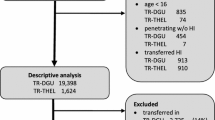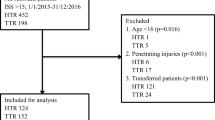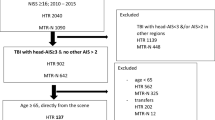Abstract
Purpose
International trauma registry comparisons are scarce and lack standardised methodology. Recently, we performed a 6-year comparison between southern Finland and Germany. Because an outcome difference emerged in the subgroup of unconscious trauma patients, we aimed to identify factors associated with such difference and to further explore the role of trauma registries for evaluating trauma-care quality.
Methods
Unconscious patients [Glasgow Coma Scale (GCS) 3–8] with severe blunt trauma [Injury Severity Score (ISS) ≥16] from Helsinki University Hospital’s trauma registry (TR-THEL) and the German Trauma Registry (TR-DGU) were compared from 2006 to 2011. The primary outcome measure was 30-day in-hospital mortality. Expected mortality was calculated by Revised Injury Severity Classification (RISC) score. Patients were separated into clinically relevant subgroups, for which the standardised mortality ratios (SMR) were calculated and compared between the two trauma registries in order to identify patient groups explaining outcome differences.
Results
Of the 5243 patients from the TR-DGU and 398 from the TR-THEL included, nine subgroups were identified and analyzed separately. Poorer outcome appeared in the Finnish patients with penetrating head injury, and in Finnish patients under 60 years with isolated head injury [TR-DGU SMR = 1.06 (95 % CI = 0.94–1.18) vs. TR-THEL SMR = 2.35 (95 % CI = 1.20-3.50), p = 0.001 and TR-DGU SMR = 1.01 (95 % CI = 0.87–1.16) vs. TR-THEL SMR = 1.40 (95 % CI = 0.99-1.81), p = 0.030]. A closer analysis of these subgroups in the TR-THEL revealed early treatment limitations due to their very poor prognosis, which was not accounted for by the RISC.
Conclusion
Trauma registry comparison has several pitfalls needing acknowledgement: the explanation for outcome differences between trauma systems can be a coincidence, a weakness in the scoring system, true variation in the standard of care, or hospitals’ reluctance to include patients with hopeless prognosis in registry. We believe, however, that such comparisons are a feasible method for quality control.


Similar content being viewed by others
References
Hemmila MR, Nathens AB, Shafi S, Calland JF, Clark DE, Cryer HG, Goble S, Hoeft CJ, Meredith JW, Neal ML, Pasquale MD, Pomphrey MD, Fildes JJ. The trauma quality improvement program: pilot study and initial demonstration of feasibility. J Trauma. 2010;68:253–62.
Shafi S, Ahn C, Parks J, Nathens AB, Cryer HM, Gentilello LM, Hemmila M, Fildes JJ. Quality of care within a trauma center is not altered by injury type. J Trauma. 2010;68:716–20.
Balogh ZJ, Martin AB. Prospective cohorts and risk adjusted outcomes for trauma. Injury. 2010;41:S24–6.
Hosmer Jr DW, Lemeshow S, Sturdivant RX. Applied logistic regression. Hoboken, New Jersey: Wiley; 2013.
Camp RC. Benchmarking: the search for industry best practices that lead to superior performance. Milwaukee: Quality Press; 1989.
Boyd CR, Tolson MA, Copes WS. Evaluating trauma care: the TRISS method. Trauma Score and the Injury Severity Score. J Trauma. 1987;27:370–8.
Steyerberg EW, Mushkudiani N, Perel P, Butcher I, Lu J, McHugh GS, Murray GD, Marmarou A, Roberts I, Habbema JDF, Maas AIR. Predicting outcome after traumatic brain injury: development and international validation of prognostic scores based on admission characteristics. PLoS Med. 2008;5:e165.
Lefering R. Development and validation of the revised injury severity classification score for severely injured patients. Eur J Trauma Emerg Surg. 2009;35:437–47.
Brilej D, Vlaović M, Komadina R. Improved prediction from revised injury severity classification (RISC) over trauma and injury severity score (TRISS) in an independent evaluation of major trauma patients. J Int Med Res. 2010;38:1530–8.
Brinck T, Handolin L, Paffrath T, Lefering R. Trauma registry comparison: six-year results in trauma care in Southern Finland and Germany. Eur J Trauma Emerg Surg. 2014. doi:10.1007/s00068-014-0470-z.
Raj R, Siironen J, Kivisaari R, Kuisma M, Brinck T, Lappalainen J, Skrifvars MB. Factors correlating with delayed trauma center admission following traumatic brain injury. Scand J Trauma Resusc Emerg Med. 2013. doi:10.1186/1757-7241-21-67.
Härtl R, Gerber LM, Iacono L, Ni Q, Lyons K, Ghajar J. Direct transport within an organized state trauma system reduces mortality in patients with severe brain injury. J Trauma. 2006;60(6):1250–6.
Pouw ME, Peelen LM, Moons KGM, Kalkman CJ, Lingsma HF. Including post-discharge mortality in hospital standardized mortality ratios: retrospective analysis of hospital episode statistics. BMJ. 2013;347:f5913.
Donebian A. Evaluating the quality of medical care. 1966. Milbank Q. 2005;83:691–729.
Raj R, Brinck T, Skrifvars MB, Kivisaari R, Siironen J, Lefering R, Handolin L. Validation of the Revised Injury Severity Classification Score in patients with traumatic brain injury. Injury. 2015;46:86–93.
Lefering R, Huber-Wagner S, Nienaber UY, Maegele M, Bouillon B. Update of the trauma risk adjustment model of the Trauma Register DGUTM : the revised injury severity classification, version II. Crit Care. 2014;18:476.
Steyerberg EW, Mushkudiani N, Perel P, Butcher I, Lu J, McHugh GS, Murray GD, Marmarou A, Roberts I, Habbema JDF, Maas AIR. Predicting outcome after traumatic brain injury: development and international validation of prognostic scores based on admission characteristics. PLoS Med. 2008;5:e165.
MRC CRASH Trial Collaborators, Perel P, Arango M, Clayton T, Edwards P, Komolafe E, Poccock S, Roberts I, Shakur H, Steyerberg E, Yutthakasemsunt S. Predicting outcome after traumatic brain injury: practical prognostic models based on large cohort of international patients. BMJ. 2008;336:425–9.
Raj R, Skrifvars MB, Bendel S, Selander T, Kivisaari R, Siironen J, Reinikainen M. Predicting six-month mortality with traumatic brain injury: usefulness of common intensive care severity scores. Crit Care. 2014;18(2):R60.
Brinkman S, Abu-Hanna A, de Jonge E, de Keizer NF. Prediction of long-term mortality in ICU patients: model validation and assessing the effect of using in hospital versus long-term mortality on benchmarking. Intensiv Care Med. 2013;39:1925–31.
Gill MR, Reiley DG, Green SM. Interrater reliability of Glasgow Coma Scale scores in the emergency department. Ann Emerg Med. 2004;43:215–23.
Author information
Authors and Affiliations
Corresponding author
Ethics declarations
Conflict of interest
Tuomas Brinck, Rahul Raj, Markus Skrifvars, Riku Kivisaari, Jari Siironen, Rolf Lefering and Lauri Handolin declare that they have no conflict of interest.
Ethical standards
Given the retrospective nature of the study, a waiver for ethical assessment was granted and the study protocol was approved by the administrative board of the TR-THEL, and was registered and approved according to the publication guideline of the TR-DGU (No. 2012-053).
Rights and permissions
About this article
Cite this article
Brinck, T., Raj, R., Skrifvars, M.B. et al. Unconscious trauma patients: outcome differences between southern Finland and Germany—lesson learned from trauma-registry comparisons. Eur J Trauma Emerg Surg 42, 445–451 (2016). https://doi.org/10.1007/s00068-015-0551-7
Received:
Accepted:
Published:
Issue Date:
DOI: https://doi.org/10.1007/s00068-015-0551-7




